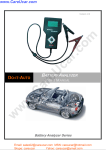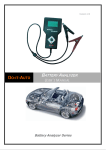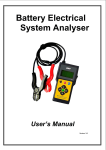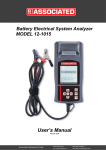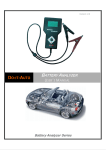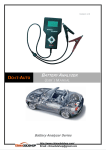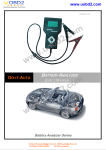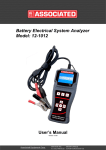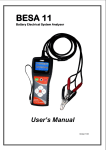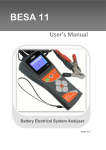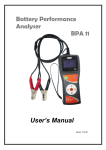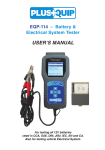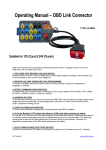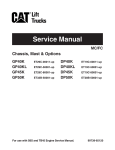Download BESA 12 - aetool
Transcript
BESA 12 User’s Manual Battery Electrical System Analyser ‐ 1 ‐ | AE TOOL LTD. l USER’S MANUAL VERSION 1307 l www.aetool.com Table of Contents 1.0 Introduction .................................................................................................................3 1.1 BESA 12 (Battery Electrical System Analyser) ....................................................................................... 3 1.2 Specifications.......................................................................................................................................... 4 2.0 Safety Measures..........................................................................................................5 2.1 Safety Precautions.................................................................................................................................. 5 2.2 Other Precautions ................................................................................................................................. 6 3.0 Working with Batteries ...............................................................................................7 4.0 The Battery Electrical System Analyser ...................................................................9 4.1 BESA 12.................................................................................................................................................. 9 4.2 Key Functions.......................................................................................................................................... 9 4.3 Functions of Individual Key.................................................................................................................... 10 5.0 BESA12 Setup ...........................................................................................................11 5.1 Printer Installation ................................................................................................................................. 11 5.2 Select Display Language ...................................................................................................................... 11 6.0 HELP Key ...................................................................................................................13 7.0 Battery Test ...............................................................................................................15 7.1 Start Testing ......................................................................................................................................... 15 8.0 Battery Rating Charts ...............................................................................................27 8.1 Japanese Industrial Standards (JIS#) Rating Chart .............................................................................. 27 8.2 DIN & EN Standards Rating Charts ....................................................................................................... 28 8.3 YUASA Battery Rating Chart ................................................................................................................. 30 8.4 Rough CCA Guide ................................................................................................................................. 31 9.0 Grounding Test .........................................................................................................31 9.1 Start Testing ......................................................................................................................................... 31 10.0 Starter Test ..............................................................................................................36 10.1 Start Testing ........................................................................................................................................ 36 11.0 Alternator Test.........................................................................................................40 11.1 Start Testing ........................................................................................................................................ 41 No Load Testing at 3,000 RPM ........................................................................................................... 41 Testing with Load at 2,000 RPM.......................................................................................................... 44 12.0 View Last Test Results ...........................................................................................47 12.1 Printing the Last Test Results ............................................................................................................. 49 13.0 PC Link.....................................................................................................................50 13.1 Installing Driver ................................................................................................................................... 50 13.2 Printing Results from Normal Printer .................................................................................................. 54 13.3 Saving Results.................................................................................................................................... 54 14.0 Warranty Information..............................................................................................55 14.1 Limited Warranty................................................................................................................................. 55 14.2 Limitations of Warranty ....................................................................................................................... 56 ‐ 2 ‐ | AE TOOL LTD. l USER’S MANUAL VERSION 1307 l www.aetool.com 1.0 - Introduction 1.1- BESA 12 (Battery Electrical System Analyser): This Analyser uses the modern technology in battery testing which can test batteries as they are without charging before test. Testing procedures are quick and easy with repeatable results. Test Results can be printed directly on attached mobile printer or it can be stored in the computer for records. 1. Battery Test: Analyses the battery condition using microprocessor controlled testing methods without the need of fully charging it before test. The unit consumes very little current during testing hence the test can be repeated numerous times without worry of draining the battery and its results are highly accurate. Extremely safe as it does not create any sparks during clamp on and it takes less than 7 seconds to obtain the full analysed results of tested battery. 2. Grounding Test: Analyses the condition of the electrical return circuit contacts resistance which were connected to the engine or chassis body from the battery terminal with results and recommendations display after test. 3. Starter Test: Checks the cranking effectiveness of the battery to predict when the battery will fail to crank a vehicle basing on voltage profiles with results and recommendations display. 4. Alternator Test: This test checks the alternator charging condition during load at 2,000 RPM and without load at 3,000 RPM with results and recommendations display after each test. This Analyser is maintenance free and does not require internal batteries. It powers up when connected to the battery posts during testing or through an external 12 Volts DC source for later review of the test results. ‐ 3 ‐ | AE TOOL LTD. l USER’S MANUAL VERSION 1307 l www.aetool.com The operation is fast and simple. When hooked up to the battery posts, the displayed instructions on the screen will lead you through and a warning tone to caution you to perform the correct steps. In event that you need assistance, there is a key. It will display information about each function when selected. Its result is consistent and repeatable and can be performed numerous times without heating up the unit. It is very safe as it does not create any sparks when connected to the battery terminals during testing on the vehicle. After the test, the results will be stored in its memory and can be reviewed again later. Also it can be printed directly on the attached mobile printer. It is equipped with an USB port to be connected to the PC to store the results or have it printed out from normal computer printer. 1.2 Specifications: Operating Voltage: 9V ~ 15V DC (max) Analysing Capacity (Amps): CCA: IEC: JIS#: CA: DC Volts Accuracy: 100 ~ 1700 100 ~ 1000 100 ~ 1700 100 ~ 1700 EN: DIN: SAE: 100 ~ 1700 100 ~ 1000 100 ~ 1700 ± 2% Reading Battery analysing time: Less than 7 seconds. Languages: Multi-languages available depending on the model selected. PC connection: Through USB port. Printer head: Thermo print head. Paper width: 57.5mm ± 0.5mm Paper roll diameter: Max. 40mm OD. Printing Speed: 50mm per sec. Working Temperature: 0ºC ~ 50ºC. Working Humidity: 10 ~ 80 % ‐ 4 ‐ | AE TOOL LTD. l USER’S MANUAL VERSION 1307 l www.aetool.com 2.0 Safety Measures: For safety reasons, read this manual thoroughly before operating the Tool. Always refer to and follow the safety instructions and testing procedures provided by the car or equipment manufacturer. The safety messages presented below and throughout this user’s manual are reminders to the operator to exercise extreme care when using this test instrument. 2.1 Safety Precautions: When the engine is running, it produces carbon monoxide, a toxic and poisonous gas. Always operate the vehicle in a well ventilated area. Do not breathe exhaust gases – they are hazardous that can lead to death. To protect your eyes from propellant object such as caustic liquids, always wear safety eye protection. Fuel and battery vapors are highly flammable. DO NOT SMOKE NEAR THE VEHICLE DURING TESTING. When engine is running, many parts (such as pulleys, coolant fan, belts, etc) turn at high speed. To avoid serious injury, always be alert and keep a safe distance from these parts. Before starting the engine for testing or trouble shooting, always make sure the parking brakes is firmly engaged. Put the transmission in Park (automatic transmission) and Neutral (manual transmission). Always block the drive wheels. Never leave vehicle unattended while testing. ‐ 5 ‐ | AE TOOL LTD. l USER’S MANUAL VERSION 1307 l www.aetool.com Never lay tools on vehicle battery. You may short the terminals together causing harm to yourself, the tools or the battery. Engine parts become very hot when engine is running. To prevent severe burns, avoid contact with hot engine parts. Do not wear loose clothing or jewelry while working on engine. Loose clothing can get caught in fan, pulleys, belts, etc. Jewelry can conduct current and can cause severe burns if comes in contact between power source and ground. When the engine is running, be cautious when working around the ignition coil, distributor cap, ignition wires and spark plugs. They are HIGH VOLTAGE components that can cause electrical Shock. Always keep a fire extinguisher readily available and easily accessible in the workshop. 2.2 Other Precautions: • This Battery Analyser is meant for testing of 12 Volts batteries only. • Its operating voltage is from 9V ~ 15V DC and should not be tested on 24V directly. It will cause damage the unit. For 12V x 2 batteries (in series or parallel), disconnect the connections and test them individually. • Battery that has just been charged by the charger contains surface charge and it should be discharged by turning ON the Head lights for 3~5 minutes before testing. • Always attached the analyser clips on the lead side of the battery terminal posts during testing so that it has a good contact. This will provide better and accurate results. • Do not attach the analyser clips directly onto the steel bolt that tightened to the battery terminal posts; this may give inaccurate readings or inconsistent results. (Note: This also applies to all other battery testing methods.) ‐ 6 ‐ | AE TOOL LTD. l USER’S MANUAL VERSION 1307 l www.aetool.com • If the battery terminal posts were oxidised or badly corroded and the connections were bad, the analyser will prompt you to check the connections. In this case, clean the terminal posts and performs testing directly on the terminal posts it-self. • During testing on the battery whist it is still in the car, make sure the engine is OFF. • Do not store the analyser near high humidity or temperature area. Exposing to extreme temperatures will cause damage to the unit. 3.0 Working with Batteries Lead-acid batteries contain a sulfuric acid electrolyte, which is a highly corrosive poison and will produce gasses when recharged and explode if ignited. It can hurt you badly. When working with batteries, make sure you have plenty of ventilation, remove your hand jewelry, watch and wear protective eyewear (safety glasses), clothing, and exercise caution. Do not allow battery electrolyte to mix with salt water. Even small quantities of this combination will produce chlorine gas that can KILL you! Whenever possible, please follow the manufacturer's instructions for testing, jumping, installing, charging and equalising batteries. ¾ Never disconnect a battery cable from a vehicle with the engine running because the battery acts like a filter for the electrical system. Unfiltered [pulsating DC] electricity can damage expensive electronic components, e.g., emissions computer, radio, charging system, etc. Turn off all electrical switches and components; turn off the ignition before disconnecting the battery. ‐ 7 ‐ | AE TOOL LTD. l USER’S MANUAL VERSION 1307 l www.aetool.com ¾ For non-sealed batteries, check the electrolyte level. Make sure it is covering the plates, and it is not frozen before starting to recharge (especially during winters). ¾ Do not add distilled water if the electrolyte is covering the top of the plates because during the recharging process, it will get warm and expand. After recharging has been completed, recheck the level. ¾ Reinstall the vent caps BEFORE recharging, recharge ONLY in well-ventilated areas, and wear protective goggle. Do NOT smoke or cause sparks or flames while the battery is being recharged because batteries give off explosive gasses. ¾ If your battery is an AGM or a sealed flooded type, do NOT recharge with current ABOVE 12% of the battery's RC rating (or 20% of the ampere-hour rating). Gel cells should be charged over a 20-hour period and never over the manufacturer's recommended level or over 14.1 Volts DC. ¾ Follow the battery and charger manufacturer's procedures for connecting and disconnecting cables and other steps to minimize the possibility of an explosion or incorrectly charging the battery. You should turn the charger OFF before connecting or disconnecting cables to a battery. Do not wiggle the cable clamps while the battery is recharging, because a spark might occur, and this could cause an explosion. Good ventilation or a fan is recommended to disperse the gasses created by the recharging process. ¾ If a battery becomes hot, over 43.3 °C (110 °F), or violent gassing or spewing of electrolyte occurs, turn the charger off temporarily or reduce the charging rate. ¾ When charging the battery in the car with an external MANUAL charger, make sure that it will not damage the vehicle's electrical system or components with high voltages. Even if this is a remote possibility, it is best to disconnect the vehicle's battery cables from the battery BEFORE connecting the charger. ‐ 8 ‐ | AE TOOL LTD. l USER’S MANUAL VERSION 1307 l www.aetool.com 4.0 - The Battery Electrical System Analyser Black Clamp to battery negative (-) post. 4.1 – BESA 12 Red Clamp to battery positive (+) post. Detachable Mobile Printer. USB port for connection to PC. Figure 1 4.2 - Keypad Functions: 7 6 8 1 4 2 3 5 Figure 2 ‐ 9 ‐ | AE TOOL LTD. l USER’S MANUAL VERSION 1307 l www.aetool.com 4.3 - Functions of Individual key: 1. Use this key to scroll up to the next item OR when it is in the keying-in Battery Ratings values mode, press this key once will increase the value by step of 5 units. 2. Use this key to shift the selection tab to the right item OR when it is in the keying-in Battery Ratings values mode, press this key once will increase the value by step of 100 units. 3. Use this key to scroll down to the next item OR when it is in the keying-in Battery Ratings values mode, press this key once will decrease the value by step of 5 units. 4. Use this key to shift the selection tab to the left item OR when it is in the keying-in Battery Ratings values mode, press this key once will decrease the value by step of 100 units. 5. Press this ENTER key will get into the selected function or proceed to the next step. 6. To EXIT the function, press this key once will return back to the previous screen. 7. This is the HELP key. Press this key will enter into the help menu and it will explain the functions of the item you have selected in detail. 8. Press this key to print the all the Test results on the Detachable Mobile Printer. The printing can be done after each test and in View Last Test mode. ‐ 10 ‐ | AE TOOL LTD. l USER’S MANUAL VERSION 1307 l www.aetool.com 5.0 – BESA 12 Setup 5.1 Printer installation 1. To install the mobile printer, first remove the detachable back cover of the Analyser by sliding outward (Fig. 3a). Then insert the mobile printer into the slot and push all the way in until it stops (Fig. 3b). B A Figure 3a Figure 3b 3. Open the printer cover, locate the place where you can place a screw and screw it tight to secure the printer (Fig.4a). Place the thermo paper roll into the slot with the paper edge facing up (Fig. 4b). Make sure the paper is about 20mm out when the printer cover is closed (Figure 4c). Insert a screw and screw it tight. Figure 4a Figure 4b Figure 4c 5.2 Select Display Language To change the display language of the Analyser, this can be done while on the wake up screen (see fig.5 below). First go to Setup Menu by pressing key until it has been highlighted and then press key to enter. ‐ 11 ‐ | AE TOOL LTD. l USER’S MANUAL VERSION 1307 l www.aetool.com ST Select Menu New: Clear Memory Continue Testing View last Test Setup Menu Then press [Enter]. Figure 5 Inside the Setup Menu (Fig.6), press (Fig.7). to gain access to the Language Menu ST Setup Menu Select Language ST Language LCD Brightness Printer PC Link English Deutsch Español Italiano [Enter] to proceed. [Exit] to quit. [Enter] to save. Figure 6 Figure 7 Select the preferred language by pressing confirm it by pressing key to scroll to the item. Then save. Once it had been saved, the display will change to the language selected. Press key to exit and get back to the Main menu screen (Fig.5) to continue your test. ‐ 12 ‐ | AE TOOL LTD. l USER’S MANUAL VERSION 1307 l www.aetool.com 6.0 – Help Key This selection helps you to familiarize with the usage of the BESA 12 as well as explaining the various test functions and its results. To get into this function, just Press key at any one of the functions displayed on the menu screens as shown below (Fig.8 and Fig 9): Select Menu ST ST Select Test Battery Test Grounding Test Starter Test Alternator Test New: Clear Memory Continue Testing View last Test Figure 8 Figure 9 Setup Menu Then press [Enter]. Then press [Enter]. EXIT For Example: If help is needed on “Battery Test”, then press change to as shown (Fig 10). Battery Test Figure 10 key on this item and the display will ST How to operate Voltage Battery ratings Internal R. LIFE Press [Help] to read [Exit] to menu. Pressing the key will scroll down to the next item “Voltage” (Fig. 11 below) and so forth until it reaches “Life”. ‐ 13 ‐ | AE TOOL LTD. l USER’S MANUAL VERSION 1307 l www.aetool.com Battery Test ST How to operate Voltage Battery ratings Internal R. LIFE Figure 11 Press [Help] to read [Exit] to menu. To see the help text, press the screen. If you need to quit, just press key again on the selected item and it will display on key will go back to the main menu (Fig. 5). Let say if you need help on “How to operate””, press into the display as shown below: key in this selection will get How to operate ST Figure 12 Press Operation: Engine must be OFF. Locate the battery. Clamp Tester to Battery [+] and [-] posts. Check battery rating [CCA, SAE, JIS, DIN, IEC, EN, CA].Key the rating values. The Tester will lead you through the whole testing process key will scroll down to the next page to continue reading the text (Fig. 13) below. Figure 13 posts. Check battery rating [CCA, SAE, JIS, DIN, IEC, EN, CA].Key the rating values. The Tester will lead you through the whole testing process. [Exit] to menu. ‐ 14 ‐ | AE TOOL LTD. l USER’S MANUAL VERSION 1307 l www.aetool.com If you wish to continue help on rest of the item like “Voltage, Battery ratings, Internal R and LIFE”, press key anytime will go back to the main menus (Fig. 11). key and then press Here just select the item you want with into the display screen with the explanation text. To exit press (Fig.5) key will enter key twice will go back to the main menu for you to begin testing. 7.0 - Battery Test 7.1 – Start Testing Performing Battery Test whilst it is still in the car: Vehicle that was running has to have its engine OFF first and then switch ON the headlights for 30 seconds to remove the surface charge. After the headlights had switched OFF, let the battery rest for at least 1 minute to recover before testing commences. The car engine and all other accessory loads must be OFF during test in order to have accurate results. When attaching the analyser clips, make sure that the battery posts were not oxidized or badly corroded. Clean them first before clamping to it. Do not clamp onto the steel bolts directly which may give inaccurate and inconsistent results. Testing on stand-alone batteries: Clean the battery posts with a wire brush prior testing. For side post batteries, install stud adaptors. Do not use steel bolts for better results. 1. Attach the Analyser clips onto the battery terminal posts [Red to (+) and Black to (-)] the unit will power up and lights up the LCD display screen as shown (Fig.14). Figure 14 BATTERY ELECTRICAL SYSTEM ANALYSER ‐ 15 ‐ | AE TOOL LTD. l USER’S MANUAL VERSION 1307 l www.aetool.com 2. It will run through a self-test and when completed it displays the Main Menu as shown: (Fig. 15) Select Menu ST New: Clear Memory Continue Testing View last Test Figure 15 Setup Menu Then press [Enter]. Here, it will let you select your choice from the Menu: New: Clear Memory Selecting this item will allow the tester to clear the last tested results stored in its memory and begin a new test. Continue Testing Selecting this item will allow you to continue the last test on the same car from where you had stopped. For example: If you had done Battery Test and later you wish to do Alternator Test or Grounding Test on the same car, just select this item and it will update the results after each test in its memory so that it can be review later or to be printed out. View Last Test Here it will let you review all the test results of the last tested car. The results stored will always be the updated ones which depend on the tests that had been done. Use or keys to scroll for the pages during viewing. Examples: Figure 16 Battery: Good Results: High Ohms Measured: 406 CCA Rating: 630 CCA Volts: 12.45 V Int. R: 6.72 mOhm Life: 76 % The grounding resistance of the engine or car chassis is high. Figure 17 Clean the cable contacts or replace cable if necessary. ‐ 16 ‐ | AE TOOL LTD. l USER’S MANUAL VERSION 1307 l www.aetool.com 3. After you have made your choice, selecting “New: Clear Memory” or “Continue…Test” will proceed to the display below: (Fig. 18) Select Test Figure 18 ST Battery Test Grounding Test Starter Test Alternator Test Then press [Enter]. 4. Pressing to select it. key once will scroll down to the next item if there is a need 5. As an example (Fig.18) the selected item was on “Battery Test” and it is being highlighted. 6. Press key will proceed to do the battery testing and if it has detected any surface charge on the battery, it will start to remove and a message is shown (Fig. 19) below. The Analyser is removing the battery surface charge now. Figure 19 Please wait for a moment! ‐ 17 ‐ | AE TOOL LTD. l USER’S MANUAL VERSION 1307 l www.aetool.com 7. If the surface charge is too great for the analyser to handle, it will prompt you with the instructions as shown: (Fig. 20) below. Battery surface charge is present! Turn the ignition key to ON position. Figure 20 Switch ON the headlights to remove surface charge. 8. Wait until the surface charge removal had completed, the analyser will advise as follows: (Fig.21) and then press key. Battery surface charge has been removed. Turn ignition key to OFF position. Figure 21 Switch OFF the headlights and then press [Enter]. 9. If there is no surface charge present, then it will straight away enter into “Select Battery” menu screen as shown in Fig. 22 Select Battery TS SLI (Wet Type) AGM (Flat/Spiral) Figure 22 [Enter] to proceed ‐ 18 ‐ | AE TOOL LTD. l USER’S MANUAL VERSION 1307 l www.aetool.com Here, selecting SLI (Wet type) battery meant that it tests Starting, Lighting and Ignition (SLI) batteries e.g. normal Flooded types like Wet Low Maintenance (Pb/Ca), Wet Standard (Pb/Pb) Batteries. If AGM (Flat/Spiral) is selected, then it will test Wet (MF) Maintenance Free (Ca/Ca), AGM/Gel Cell VRLA (Ca/Ca) Batteries. 10. Once the selection has been done, it will proceed to the display as shown in Fig 23: Select Rating Figure 23 TS CCA SAE DIN JIS IEC EN CA Unknown 11. Before selecting the ratings ‘CCA, SAE, EN, IEC, DIN, CA and JIS #’ from the menu, check the battery specification value. This value can be checked on the battery labels as some of the examples shown below: ‐ 19 ‐ | AE TOOL LTD. l USER’S MANUAL VERSION 1307 l www.aetool.com If it is selected under JIS # (Japanese Industrial Standard) then the display will prompt you as shown (Fig.24) below. Please refer to the charts provided for converting JIS# to CCA ratings before keying in the values. Figure 24 Press [Enter] to continue... Refer to the battery model (example: 80D26L or NX110-5L) on the Cold Cranking Amps (CCA) Table list supplied separately or from this manual on page 27 & 28 (See example Fig.25 below.) Figure 25 ‐ 20 ‐ | AE TOOL LTD. l USER’S MANUAL VERSION 1307 l www.aetool.com Press key and the display will show: (Fig.26) below: Input Battery Rating Increase/decrease: S Single digit T W By hundredth X 500 CCA Figure 26 Press [Enter] to proceed. 12. Referring to the Table list (Fig.25) basing on 80D26L, check the battery type: WET, MF, Sealed MF or Closed MF (CMF) as each category has different CCA ratings. For instance, if the battery is a Sealed MF (CMF) then it is rated at 630 CCA. Note: WET MF SMF - Wet Cell Type Maintenance Free Type Closed or Sealed Maintenance Free 13. To enter the value 630, press key will increase the original value of 500 (Fig.26) by step of 100 units to 600. Likewise use key to increase the last two digits (00) to 30 by step of 5 units for each pressing. (Fig. 27) Input Battery Rating Increase/decrease: S Single digit T W By hundredths X Figure 27 630 CCA Press [Enter] to proceed. ‐ 21 ‐ | AE TOOL LTD. l USER’S MANUAL VERSION 1307 l www.aetool.com Once the CCA rating of the battery is confirmed, press testing process. Refer to the display below (Fig. 28). key will start the Analysing ... Figure 28 Please wait! 14. For less than 7 seconds, the results of the testing will be displayed on the LCD screen. (Fig. 29) 1 Battery: Good 3 Measured: 406 CCA Rating: 630 CCA Volts: 12.45 V Int. R: 6.72 mOhm Life: 76% 2 6 4 5 Figure 29 Interpretations of the above results: 1. RESULTS: Good A very straight forward display of the final results basing on the evaluation of the tested condition. ‘Good’ indicates the battery in good condition. ‘Replace’ indicates that the battery needs to be replaced. If not, the battery will fail anytime without any warning. ‐ 22 ‐ | AE TOOL LTD. l USER’S MANUAL VERSION 1307 l www.aetool.com 2. Volts : 12.45V The volts here indicated the State of Charge (SOC) of the tested battery which is 12.45V during open circuit condition. [Slightly above 80% SOC for Flooded (Lead Acid) batteries by referring to the table below.] SOC 100 % 90 % 80 % 75 % 50 % 3. 4. Wet - Flooded AGM(Flat/Spiral) AGM (Gel) (Sb/Ca, Sb/Sb) Wet MF (Ca/Ca) 12.60V or higher 12.80V or higher 12.85V or higher 12.58 V 12.72 V 12.77 V 12.44 V 12.64 V 12.69 V 12.40 V 12.60 V 12.65 V 12.20 V 12.30 V 12.35 V Measured: 406 CCA It means that the battery tested has a capacity of 406 CCA power available. CCA ratings has been used here, therefore the tested result is in CCA and if other rating (DIN, SAE, JIS, IEC, CA, or EN) were selected, it will base on the respective rating to calculate and show the results in that selected rating. Rating: 630 CCA This is the battery capacity rated output which was stated on the label. Refer page 19 on how the rating is obtained. Please take Note: This output value (406 CCA) is related to the actual power available in the battery in relation to that battery's rating (630 CCA). On average, a new battery's CCA as measured by this tester will read 10-15 % higher than its stated rating. As the battery ages, the CCA number measured by this tester will decrease so it reads near its rating. While this value is not the same as a CCA test, it is the best available measurement for showing a battery's current condition in relation to its rating. From the above example, a 630 CCA rated battery measuring 406 CCA available power does not mean that the battery would pass a CCA test at 406 CCA. The available power reading shows that the battery is not able to perform up to its rated ability (630 CCA). In comparison to another battery when fully charged, the 630 CCA battery measuring 406 CCA is no stronger than a 400 CCA battery showing 400 CCA available power when fully charged. The available power number is meant for comparison to its own rating. In fact, in this example the 630 CCA battery is failing to perform to its rating, while the 400 CCA battery is still working. ‐ 23 ‐ | AE TOOL LTD. l USER’S MANUAL VERSION 1307 l www.aetool.com Basing on SAE, CCA test is a manufacturing process control test applicable only on new, fully charged batteries. It does not produce an actual value, but is a PASS / FAIL test. It measures the discharge load, in amps, that a battery can supply for 30 seconds at 0°F/-18°C while maintaining a voltage of 1.2 volts per cell (7.2 volts per battery) or higher. Thus, the CCA test shows the minimum power requirement for the battery as rated, which means a battery rated at 400 CCA must measure 7.2 volts or above for 30 seconds when a load of 400 amps is applied at 0°F/ -18°C. The above methods also hold for DIN, IEC, JIS, EN basing on its individual ratings. 5. Int. R (Internal Resistance): 6.72mΩ In normal condition, the internal resistance should fall between 2.0 mΩ ~ 15.0 mΩ. As a matter of fact, the higher the battery CCA readings obtained the lower the internal resistance should be. 6. LIFE: 76 % This is an indication of the battery life expectancy in percentage. If the life falls below 45 %, the RESULT will display “Replace” and it is time to change to a new battery. Explanation of the following terms used as shown on the LCD display: • CCA (Cold Cranking Amps) – most commonly used Standard. CCA is a rating used in the battery industry to rate a battery’s ability to start an engine in cold temperatures. This rating is the number of amperes that a new fully charged battery can delivery at 0°F (-18°C) for 30 seconds, while maintaining a voltage of at least 7.2 Volts for a 12V battery during cranking. • SAE (The Society of Automotive Engineers) Standard. SAE has established Cold Cranking Amperes (CCA) rating for batteries as their standard. Therefore this rating is the same as CCA rating as mentioned above. • IEC (International Electrotechnical Commission) Standard. IEC amperes rating require that at 0°F (-18°C), the number of amperes that the 12V battery can deliver while maintaining a voltage of at least of 8.4 Volts for 60 seconds during cranking. • EN (European Norms) Standard. EN amperes rating require that at 0°F (-18°C), the number of ampere that the 12V battery can deliver while maintaining a voltage of at least 6.0 Volts for 180 seconds during cranking. ‐ 24 ‐ | AE TOOL LTD. l USER’S MANUAL VERSION 1307 l www.aetool.com • JIS# (Japanese Industrial Standard) JIS # amperes’ rating is based on Ampere Hours and is calculated using 20 hours rating. In this manual, it is using CCA ratings reference table list provided basing on the JIS model number (See page 24 & 25). • DIN (Deutsches Industrie Normen) Standard. Basing on DIN , the rating requires that at 0°F (-18°C), the 12V battery is able to deliver the number of amperes while maintaining a voltage of at least of 9.0 Volts for 30 seconds and 8.0 Volts for 150 seconds during cranking. • CA (Cranking Amperes) Rating. This rating is the number of amperes that a new fully charged battery can delivery at 32°F (0°C) for 30 seconds, while maintaining a voltage of at least 7.2 Volts for a 12V battery during cranking. • Unknown If you are not sure which ratings (CCA, EN, IEC, JIS or DIN) that the battery is based on, then choose this setting. It will show the battery’s Voltage (State of Charge), CCA and the Internal Resistance (m Ohm) only. This selection can also be used to test 12V - Deep Cycle Batteries. An example of the results display is shown below: (Fig.30) Battery: Measured: 220 CCA Volts: 12.26 V Int. R: 6.24 mOhm Figure 30 To determine the condition of the tested Deep Cycle Batteries, refer the Volts reading – State of Charge (should not fall below 12.60V when fully charged for Lead Acid Batteries, 12.85V for Gel Batteries and 12.80V for AGM Batteries) and the Internal Resistance [Int. R] of the tested battery should not be more 15 mOhm readings. ‐ 25 ‐ | AE TOOL LTD. l USER’S MANUAL VERSION 1307 l www.aetool.com Batteries that had been left idle for long periods can still be tested with this analyser. To perform the test, just clamp the analyser clips onto the battery terminals and it will display the screen (Fig.31) as shown if its voltage falls below the normal 12.0 volts. Battery voltage is below 12.00 Volts! Figure 31 Press [Enter] to continue... Press key to continue and the display will show: (Fig.32) Select Rating TS CCA SAE DIN JIS IEC EN CA Unknown Figure 32 Check the battery ratings and enter it as described in steps 10 to 12 (page 19~21) and the results will show as an example below: (Fig. 33 and Fig.34) Battery: OK-Recharge Battery: To replace Measured: 220 CCA Rating: 400 CCA Volts: 11.96 V Int. R: 12.24 mOhm Measured: 120 CCA Rating: 400 CCA Volts: 10.56 V Int. R: 20.24 mOhm State of Charge is low! Charge battery and test again. State of Charge is low! Internal resistance is high. Figure 33 Figure 34 ‐ 26 ‐ | AE TOOL LTD. l USER’S MANUAL VERSION 1307 l www.aetool.com Fig.33 Results shown [OK-Recharge], it indicated that the battery has to be fully charged first before repeating the test. For Fig.34, the Results shown [To replace], this meant that the battery need to be replaced as its internal plate resistance [Int. R] is higher than 15 mOhm. 15. Pressing the key at any moment will exit and return back to the main menu screen (Fig.18). 8.0 – Battery Ratings Charts 8.1 Japanese Industrial Standard (JIS#) CCA Ratings Battery Model (JIS#) NEW 26A17R 26A17L 26A19R 26A19L 28A19R 28A19L 32A19R 32A19L 26A17R 26B17L 28B17R 28B17L 28B19R 28B19L 32B20R 32B20L 32C24R 32C24L 34B17R 46B24R 46B24RS 46B24LS 46B26R 46B26L 46B26RS 46B26LS 48D26R 48D26L 50B24L 50B24R 50D20R 50D20L CCA Rating OLD WET 200 200 200 200 250 250 270 270 200 200 245 245 245 245 270 270 240 240 280 325 325 325 360 360 360 360 280 280 390 390 310 310 12N24-4 12N24-3 NT50-N24 NT50-N24L NX60-N24 NX60-N24L NS40S NS40LS NS40 NS40L N40 N40L NS60 NS60S NS60LS NS60 N50 N50L NT80-S6L NT80-S6 MF 220 220 CMF SMF 264 264 295 295 325 325 400 400 369 360 360 420 420 420 360 360 420 420 380 380 480 480 Battery Model (JIS#) NEW 34B17L 34B19R 34B19L 34B19RS 34B19LS 36B20R 36B20L 36B20RS 36B20LS 38B20R 38B20RS 38B20L 38B20LS 40B20L 40B20R 42B20L 42B20RS 42B20LS 46B24L 75D31L 80D23R 80D23L 80D26R 80D26L 85B60K 85BR60K 95D31R 95D31L 95E41R 95E41L 105E41R 105E41L OLD CCA Rating NX110-5 NX110-5L WET 280 270 270 270 270 275 275 275 275 330 330 330 330 330 330 330 330 330 325 450 580 580 580 580 NX120-7 NX120-7L N100 N100L N100Z N100ZL 620 620 515 515 580 580 NS40ZA NS40ZAL NS40ZAS NS40ZALS NS40Z NS40ZL NS40ZS NS40ZLS NX60-N24 NT60-N24S NX60-24L NX60-24LS NS60L N70ZL MF 325 325 325 325 300 300 300 300 340 340 340 340 400 400 400 400 360 360 360 360 410 410 410 410 360 540 420 725 580 580 630 630 500 500 850 850 770 770 880 880 660 660 640 640 720 720 ‐ 27 ‐ | AE TOOL LTD. l USER’S MANUAL VERSION 1307 l CMF SMF www.aetool.com Battery Model (JIS#) NEW 50D23R 50D23L 50D26R 50D26L 55B24R 55B24L 55B24RS 55B24LS 55D23R 55D23L 55D26L 55D26R 60D23R 60D23L 65D23R 65D23L 65D26R 65D26R 65D31R 65D31L 70D23R 70D23L 75D23R 75D23L 75D26R 75D26L 75D31R 8.2 CCA Rating OLD 85BR60K 85B60K 50D20R 50D20L NX100-S6 NX100-S6L NT80-S6S NT80-S6LS WET 500 500 435 435 430 430 355 355 350 350 520 520 420 420 415 415 390 390 490 490 500 500 490 490 450 N50ZL N50Z NS70 NS70L N70 N70L 35-60 25-60 F100-5 F100-5L N70Z MF 370 370 420 420 420 420 480 480 440 440 CMF SMF 500 500 500 500 500 500 525 525 540 540 520 520 520 520 540 540 520 520 580 580 625 625 630 630 580 580 580 580 540 735 Battery Model (JIS#) NEW 105F51R 105F51 115E41R 115E41L 115F51R 115F51L 130E41R 130E41L 130F51R 130F51L 145F51R 145F51L 145G51R 150F51R 150F51L 165G51R 165G51L 170F51R 170F51L 180G51R 180G51L 195G51R 195G51L 190H52R 190H52L 245H52R 245H52L OLD N100Z N100ZL NS120 NS120L N120 N120L NX200-10 NX200-10L NS150 NS150L N150 NT200-12 NT200-12L NS200 NS200L NX250-12 NX250-12L NT250-15 NT250-15L NX300-51 NX300-51L N200 N200L NX400-20 NX400-20L CCA Rating WET 580 580 650 650 650 650 800 800 800 800 780 780 780 640 640 935 935 1045 1045 1090 1090 1145 1145 925 925 1530 1530 MF 800 800 800 800 960 960 960 960 920 920 900 1100 980 980 1100 1100 1250 1250 DIN & EN Standards Rating Chart Amps Battery Model No. DIN EN Battery Model No. DIN EN 52805 52815 53517 53520 53521 53522 53621 53624 53625 53638 53646 53653 53836 53890 54038 54039 54232 54312 54313 180 180 175 150 150 150 175 175 175 175 175 175 175 175 175 175 175 210 220 240 240 300 240 240 240 300 300 300 300 300 300 300 300 300 300 300 360 330 55057 55068 55069 55218 55414 55415 55421 55422 55423 55427 55428 55457 55529 55530 55531 55545 55548 55552 55559 320 220 220 255 265 265 265 265 300 300 300 265 220 255 255 255 255 255 255 540 390 390 420 450 450 450 450 510 510 510 450 360 420 420 420 420 420 420 Amps ‐ 28 ‐ | AE TOOL LTD. l USER’S MANUAL VERSION 1307 l CMF SMF www.aetool.com 1300 1300 Battery Model No. Amps DIN 54317 54324 54434 54437 54449 54459 54459L 54464 54465 54466 54469 54519 54523 54524 54533 54537 54545 54551 54577 54578 54579 54580 54584 54590 54612 54801 54827 55040 55041 55042 55044 55046 55048 55056 56638 56641 55647 56821 56820 56828 57024 57029 57113 57114 57217 57218 57219 57220 57230 57412 57412L 57413 57512 57513 57531 210 220 210 210 210 210 210 220 210 210 210 210 220 220 210 190 190 220 220 220 220 220 220 210 210 190 240 265 220 220 265 300 300 320 300 300 300 315 315 315 315 315 400 400 420 420 420 420 380 400 400 400 350 350 350 Amps EN Battery Model No. DIN EN 360 330 360 360 360 360 360 330 360 360 360 360 300 300 360 300 300 300 300 300 300 300 300 330 360 300 360 450 360 360 450 510 540 540 510 510 510 540 540 540 540 540 680 680 720 720 720 720 640 680 680 680 570 570 570 55559L 55563 55564 55565 55565L 55566 55567 55811 56012 56048 56049 56068 56069 56073 56077 56091 56092 56111 56216 56218 56219 56220 56225 56311 56312 56318 56322 56323 56420 56530 56618 56619 56620 56633 60026 60038 60044 60527 60528 61017 61018 61023 61047 61048 62034 62038 62045 62529 63013 63545 63549 64020 64028 64035 64036 255 255 255 255 255 265 255 360 230 250 250 250 250 250 300 360 300 300 300 300 300 280 300 300 300 300 300 300 300 300 300 300 300 300 440 500 500 410 410 400 400 450 450 450 420 420 420 450 470 420 420 325 520 520 460 420 420 420 420 420 450 420 540 420 390 390 390 390 390 510 540 510 540 510 510 510 510 510 510 510 510 510 510 510 510 510 510 510 510 720 760 760 680 680 680 680 760 760 760 680 680 680 760 680 680 680 550 760 760 760 ‐ 29 ‐ | AE TOOL LTD. l USER’S MANUAL VERSION 1307 l www.aetool.com 8.3 Battery Model No Amps DIN EN 58424 58513 58514 58515 58521 58522 58527 58811 58815 58820 58821 58827 58833 58838 59017 59018 59040 59215 59218 59219 59226 59514 59518 59519 59615 59616 60018 60019 450 320 320 450 320 320 395 440 395 395 395 400 400 400 360 360 360 450 290 290 450 320 395 395 360 360 250 250 760 540 540 760 540 540 640 720 640 640 640 640 680 680 600 600 600 760 480 480 760 540 640 640 600 600 410 410 Amps Battery Model No DIN EN 64317 64318 64323 65513 65514 65515 67043 67045 68021 68032 68034 68040 70027 70029 70036 70038 71014 71015 72512 73011 88038 88046 88056 88066 88156 88074 88092 540 540 540 540 570 570 600 600 570 600 600 570 630 630 570 630 700 700 680 740 175 210 265 300 320 400 400 900 900 900 900 900 900 1000 1000 950 1000 1000 950 1050 1050 950 1050 1150 1150 1150 1200 300 360 450 510 540 680 680 YUASA Battery Rating Chart Battery Model No. 24-500 34-6MF 34-60 34-610MF 34-710 35-580 41-580 55D23R 58-6MF 58-60 58-530 65-70 CCA Battery Model No. CCA 500 500 525 610 710 580 580 522 530 525 530 700 65-730 65-900 74-60 75-6MF 75-72 75A-72 75-660 78A-72 78-710 GR40R-MF GR40R-CMF GTH40 730 850 525 615 500 630 660 670 710 700 820 277 Battery Model No. CCA GTH40L GTH40S GT50L GTH55DL GTH60L GTH60DL GTH75DL GTH75DR GR96R-MF GR96R-CMF 276 275 356 356 325 325 520 521 500 580 ‐ 30 ‐ | AE TOOL LTD. l USER’S MANUAL VERSION 1307 l www.aetool.com 8.4 Rough CCA Guide Given below is a rough CCA ratings guide for any unknown battery model basing on the capacity of the vehicle: Vehicle Capacity Approximate Battery CCA Rating 1200 ~ 1600 cc 350 CCA 1600 ~ 2000 cc 500 CCA 2000 ~ 3000 cc 650 CCA 3000 cc and above 750 CCA M. Benz over 3000 cc 760 CCA 9.0 – Grounding Test The engine body and the vehicle chassis are always connected to the battery negative terminal to provide the electrical return path (grounding) for all the electrical components. Due to the surrounding environmental effect, the surface contacts of these joints or connections of these circuits will subject to oxidation and corrosion in a matter of time rendering them to have high resistance in it. One typical example is the connection at the battery terminals where oxidation and corrosion takes place very often. If these contacts were no good then it will pose a lot of electrical problems to the vehicle. To check the grounding condition, this Analyser will measure the resistance from the engine body contact to the battery terminal then it will display the results and the recommendations. 9.1 – Start Testing 1. Make sure that the engine is switched OFF. Attach the clips onto the battery terminal posts and the analyser will power up and lights up the LCD display screen as shown (Fig.35). Figure 35 BATTERY ELECTRICAL SYSTEM ANALYSER ‐ 31 ‐ | AE TOOL LTD. l USER’S MANUAL VERSION 1307 l www.aetool.com 2. It will run through a self-test and when completed it displays the Main Menu as shown: (Fig. 36) ST Select Menu Figure 36 New: Clear Memory Continue Testing View last Test Setup Menu Then press [Enter]. 3. After you have made your choice, selecting “New: Clear Memory” or “Continue…Test” will proceed to the display below: (Fig. 37) Select Test ST Battery Test Grounding Test Starter Test Alternator Test Then press [Enter]. Figure 37 key once will scroll down to the ‘Grounding Test’ (Fig.38) 4. Pressing Select Test ST Battery Test Grounding Test Starter Test Alternator Test Then press [Enter] Figure 38 ‐ 32 ‐ | AE TOOL LTD. l USER’S MANUAL VERSION 1307 l www.aetool.com 5. Press key will proceed to the display as follows: (Fig. 39) Grounding Test Clip the Black clip to engine body or the car chassis and the Red clip to the battery [+] post. Press [Enter] to begin. Figure 39 6. Now transfer the BLACK tester clip from the battery [-] terminal to a suitable position on the engine or chassis body leaving the RED clip still attached to the battery [+] terminal. 7. Press key again and it will starts analyzing (Fig. 40) Analysing ... Please wait! Figure 40 8. Once it has finished analysing, it will prompt you with an instruction (Fig. 41) stating that you have should unclamp the Black tester clip from the engine or chassis body and transfer to the battery negative [-] terminal within 20 seconds time limit if not the testing procedure has to be repeated again as the gathered data will be lost. ‐ 33 ‐ | AE TOOL LTD. l USER’S MANUAL VERSION 1307 l www.aetool.com Grounding Test Now transfer the Black clip to the battery [-] post. The time limit given is 20 seconds before the memory is lost. Figure 41 9. Once the Black clip is clamped onto the battery [-] terminal, the Analyser display will light up as shown. (Fig. 42) Grounding Test Press [Enter] to continue the test. Figure 42 10. Now you need to press (Figure 43). key to proceed and the display will show as follows Analysing ... Please wait! Figure 43 ‐ 34 ‐ | AE TOOL LTD. l USER’S MANUAL VERSION 1307 l www.aetool.com 11. If the measured resistance reading is within limits, then it will display as follows (Fig. 44) Results: OK The grounding resistance of the engine or car chassis is within limit. Figure 44 12. If the measured resistance reading has gone beyond the limits, then it will display the screen as follows (Fig. 45). Results: High Ohms The grounding resistance of the engine or car chassis is high. Clean the cable contacts or replace cable if necessary. Figure 45 Note: The above indicates that the ground contact from the engine body to the battery is bad. Check for rusted or corroded point of contacts. If found, dismantle it for cleaning or replace before fixing back. Repeat the test again after fixing. Another thing is that if you suspect that the result is in question, you may conduct the test with the Black clip clamp at different location. ‐ 35 ‐ | AE TOOL LTD. l USER’S MANUAL VERSION 1307 l www.aetool.com 13. If you did not follow the right procedures during the testing, it will display the results as follows (Fig. 46) below: Results:Not detected Wrong procedures. Try again and follow the step by step instructions given. Figure 46 14. To exit the program, pressing the key at any moment will exit and return back to the main menu screen (Fig.38). 10.0 – Starter Test This test actually checks the cranking effectiveness of the battery and also can predicts when the battery will fail to crank a vehicle. This Analyser is designed to address the weakness of conventional testers with its cranking power measurements. Simply connect the analyzer to the battery in the vehicle and start the engine! To understand the working principle of the tests, let’s look at the wave form displays taken during the cranking tests with an oscilloscope. ‐ 36 ‐ | AE TOOL LTD. l USER’S MANUAL VERSION 1307 l www.aetool.com Figure (A) above shows the voltage profile of a healthy battery during the cranking of an engine. The graph starts off at the battery's nominal voltage, and a voltage drop is detected when the vehicle is cranked. The voltage recovers to the battery's nominal voltage and eventually rises to approximately 14.4 V when the alternator starts charging the battery. For Figure (B) where a typical 2 year-old battery, you noticed the difference in the voltage drop which indicates that it is weaker but still usable. Whereas Figure (C) represents a very weak battery that can barely crank a car and is due to fail in the very near future. As voltage profiles can indicate the relative ability of the tested battery in starting an engine, so there is no need for knowledge on the starter motor requirement or the battery's rating and size. BESA-12 will capture the highest voltage drop and calculate the final results which should not be lower than 9.6V average during cranking and computes the result after the test. 10.1– Begin Testing 1. With engine OFF, place the vehicle transmission in NEUTRAL for Manual and PARK for Automatic then apply the parking brake. 2. Connect the analyser to the battery terminals and the display will light up as shown (Fig 47). BATTERY ELECTRICAL SYSTEM ANALYSER Figure 47 3. After you have made your choice, selecting either “New: Clear Memory” or “Continue…Test” will proceed to the display below: (Fig. 48) ‐ 37 ‐ | AE TOOL LTD. l USER’S MANUAL VERSION 1307 l www.aetool.com ST Select Menu New: Clear Memory Continue Testing View last Test Figure 48 Setup Menu Then press [Enter]. 4. From the main MENU, select ‘Starter Test’ by scrolling down using key. The screen will show (Fig.49). ST Select Test Figure 49 Battery Test Grounding Test Starter Test Alternator Test Then press [Enter]. 2. Press key to continue and the display will show: (Fig.50) Starter Test Battery: Figure 50 12.45V Crank engine now until it starts. Then press [Enter]. 3. Switch the ignition key to ON and start cranking the engine until it starts. Immediately after that press follows (Figure 51): key and the results will show as ‐ 38 ‐ | AE TOOL LTD. l USER’S MANUAL VERSION 1307 l www.aetool.com Result: OK Min. Volts: 10.56V Volt Drop: Normal Figure 51 Press [Exit] to main menu. 4. If the voltage drop is too great during the cranking, the tested results will display as follows (Figure 52) and will prompt you to check the starter system. Result: High Drop Min. Volts: 8.56V Volt Drop: High Figure 52 Check starter relay, battery terminals or battery has aged. Press [Exit] to main menu. 5. During cranking when it detects that there is no drop in voltage, it will display the following screen (Figure 53). Result: Not detected Figure 53 No change in volt drop. Check clamping at battery side and test again. Press [Exit] to main menu. 6. Pressing the key at any moment will exit and return back to the main menu screen. (Fig.49) ‐ 39 ‐ | AE TOOL LTD. l USER’S MANUAL VERSION 1307 l www.aetool.com 11.0 – Alternator Test An alternator is the device used to produce the electricity the car needs to run and to keep the battery charged. The alternator uses the principle of electromagnetic induction to produce voltage and current. The four main parts of the alternator are the Rotor, Stator, Diode Pack, Voltage Regulator and an Ammeter or Indicator Light to inform the driver of any problems. All of these parts must be in good working order for the alternator to do its job. The Rotor is a coil of wire wound around an iron core. The Rotor rotates as the alternator shaft rotates and current passes through brushes. The Rotor winding passes the Field current. This causes the Rotor to produce a magnetic field. So basically the Rotor is a rotating electro magnet. The Stator is a set of three windings fixed to the case of the alternator and these windings are static i.e. they don’t rotate. As the Rotor rotates its magnetic field “cuts” each Stator winding in turn, this induces a current in each winding. The outputs from the Stator windings are 120 degrees apart and are alternating current (AC). But vehicles run on DC current, so we need something that will convert the AC current to DC current. This is the job of the diode pack. A diode is an electrical one-way check valve that will let current flow in only one direction. The typical diode pack uses four diodes to accomplish this. AC current is feed in on one side of the diode pack and DC current comes out the other side. The diode pack here will rectify the alternating 3 phases from the Stators and combine them into a single Direct Current which also works the dash ammeter or indicator light. Now that we have a DC current that the vehicle can use, we need a way to control that current. That is the job of the voltage regulator. As the name implies, it regulates the voltage going to the battery. It does this by turning current to the field (stator) terminal of the alternator on and off. If the battery voltage goes below 13.5 volts, the voltage regulator sends current to the field terminal and allows the alternator to start charging. Current will then flow into the battery and bring it up to full charge. If the voltage goes above 15.0 volts, the voltage regulator shuts off the current to the field terminal and keeps the battery from overcharging and cooking itself. This is how the voltage regulator controls the alternator output. ‐ 40 ‐ | AE TOOL LTD. l USER’S MANUAL VERSION 1307 l www.aetool.com When you first start your vehicle, the alternator needs some current to start working. The voltage regulator supplies this current from the battery to the field (stator) terminal of the alternator to get it started. The state of charge of the battery controls amperage output of the alternator. When the battery has a full charge, the electro-motive force of the voltage lowers the amperage to almost zero. As the battery charge wears down, the electro-motive force is not enough to stop the amperage, so it flows into the battery and charges it again. 11.1 – Start Testing This test is to check the MAX and MIN charging voltages output of the alternator at 3000 RPM without load and 2000 RPM with all loads ON. With this test you can determine the alternator’s condition when in reference with the vehicle’s Service Manual. No load testing at 3,000 RPM 1. With engine OFF, place the vehicle transmission in NEUTRAL for Manual and PARK for Automatic and apply the parking brake. 2. Attach the Analyser clips onto the battery terminal posts and it will power up and lights up the LCD display screen as shown (Fig.54) Figure 54 BATTERY ELECTRICAL SYSTEM ANALYSER 3. It will run through a self-test and when completed it displays the Main Menu as shown: (Fig. 55) Select Menu ST New: Clear Memory Continue Testing View last Test Figure 55 Setup Menu Then press [Enter]. ‐ 41 ‐ | AE TOOL LTD. l USER’S MANUAL VERSION 1307 l www.aetool.com 4. After you have made your choice, selecting either “New: Clear Memory” or “Continue…Test” will proceed to the display below: (Fig. 56) Select Test Figure 56 ST Battery Test Grounding Test Starter Test Alternator Test Then press [Enter]. key to scroll down to the ‘Alternator Test’ (Fig.57) 5. Pressing Select Test ST Battery Test Grounding Test Starter Test Alternator Test Figure 57 Then press [Enter] key to continue and the display will show: (Fig.58) 6. Press No Load Test Start the car engine and keeps it running. Figure 58 Then press [Enter] to begin. Start the engine and then press key again and the screen will ‐ 42 ‐ | AE TOOL LTD. l USER’S MANUAL VERSION 1307 l www.aetool.com prompt you as shown below (Fig. 59). Figure 59 No Load Test Make sure all electrical loads are turn OFF. Rev the engine to 3,000 rpm. Press [Enter].Hold on to this 3,000 rpm for 10 seconds and release the pedal. Follow the instructions, make sure that all loads (lights, air-condition, etc) are OFF. Rev the engine up to 3,000 ~ 3,500 RPM by referring to the dashboard meter, then press key and maintain the engine speed for about 10 seconds and release the pedal. The maximum and minimum voltages values will be captured. After that press Charging Volts range limit. key again and it show as below (Fig 60.) No Load Test At 3,000 rpm: Average Charging Volts Av Volts: 14.2V <15.0V: Max. 14.6V >13.3V: Min. 13.8V Captured Volts readings Press [Enter] for results. Figure 60 With the captured readings, analysis can done by referring to the limits as indicated that MAX voltage should not exceed 15.0V (max. voltage at 3,000 RPM) and MIN voltage should be more than 13.3V (min voltage during idling speed). ‐ 43 ‐ | AE TOOL LTD. l USER’S MANUAL VERSION 1307 l www.aetool.com 7. Press key will show the results of the test (Figure 61): Results: Good At 3,000 rpm, No load Test: Average Charging Volts: 14.2V Press [Enter] to continue to Loading Test. Figure 61 8. If either minimum or maximum charging volts are not within the voltage range limits then it will display one of the screen as below (Figures 62 & 63) and it will prompt you to check the charging system for the fault. Results: Low charge Results:High charge At 3,000 rpm, No load Test: >13.3V: Min 13.2V At 3,000 rpm, No load Test: <15.0V: Max. 15.6V Check for loose belt and the alternator. Check alternator and the regulator. Figure 62 Figure 63 Testing with load at 2,000 RPM As more electrical accessories, such as lights, heater, air condition, car stereos, etc. were used; the electro-motive force decreases and this will allow more amperage from the alternator to flow into the battery to compensate for the added load. This test is to check the alternator’s behavior during loading. ‐ 44 ‐ | AE TOOL LTD. l USER’S MANUAL VERSION 1307 l www.aetool.com 9. Continue from the previous test (either Fig. 61, 62 or 63); proceed to the next step by pressing (Fig.64) key will enter to the display as follows. Loading Test Switch ON all electrical loads. Rev engine up to 2,000 rpm. Press [Enter].Hold on to this 2,000 rpm for 10 seconds and release the pedal. Figure 64 Follow the instructions, switch ON all electrical loads (Head Lights, Radio, Air-condition, Heater, etc). Rev the engine up to 2,000 ~ 2,500 RPM by referring to the dashboard meter, then press key and maintain the engine speed for about 10 seconds and release the pedal. The maximum and minimum voltages values will be captured. (Fig.65) Loading Test Normal Charging range limit. Average Charging volts. At 2,000 rpm: Av.Volts: 13.3V >13.5V: Max. 13.8V >12.5V: Min. 12.8V Captured Volts readings Press [Enter] for results. Figure 65 With the captured readings, analysis can done by referring to the limits as indicated that MAX voltage should exceed 13.5V (max. voltage at 2,000 RPM) and MIN voltage should be more than 12.5V (min voltage during idling speed). ‐ 45 ‐ | AE TOOL LTD. l USER’S MANUAL VERSION 1307 l www.aetool.com After that press key again and the results will be shown as below (Fig 66.) Results: Good At 2,000 rpm, Loading Test: Average Charging Volts: 13.3V Figure 66 10. If either minimum or maximum charging volts are not within the voltage range limits then it will display one of the screen as below (Figures 66 & 67) and it will prompt you to check the alternator system for the fault. Results: Low charge Results: Low charge At 2,000 rpm, Loading Test: >13.5V: Max. 13.3V At 2,000 rpm, Loading Test: >12.5V: Min. 12.4V Check for loose belt and the alternator. Check for loose belt and the alternator. Figure 67 Figure 68 11. To exit the program, pressing the key at any moment will exit and return back to the main menu screen (Fig.57). ‐ 46 ‐ | AE TOOL LTD. l USER’S MANUAL VERSION 1307 l www.aetool.com 12.0 – View Last Test Results To view the results of the last test, BESA 12 has to be connected to an external power source by either clamping its clips directly to a 12Volt car battery or connected to a PC via the USB port. USB Cable Figure 69 1. Once power up, the wakeup screen will display as follows: Figure 70 BATTERY ELECTRICAL SYSTEM ANALYSER 2. It will run through a self-test and when completed it displays the Main Menu as shown: (Fig. 71) Select Menu Figure 71 ST New: Clear Memory Continue Testing View last Test Setup Menu Then press [Enter]. ‐ 47 ‐ | AE TOOL LTD. l USER’S MANUAL VERSION 1307 l www.aetool.com 3. Pressing Fig. 72 below. key once will scroll down to the ‘View last Test’ ST Select Menu New: Clear Memory Continue Testing View last Test Figure 72 Setup Menu Then press [Enter]. 4. Press key will proceed to display the last test results depending the type of test you had performed earlier. (Fig. 73) Battery: Good Figure 73 Measured: 406 CCA Rating: 630 CCA Volts: 12.45 V Int. R: 6.72 mOhm Life: 76% 5. To view the next page, press want. or key to get to the page you Some examples below are: (Figs. 74, 75, 76 & 77) Figure 74 Results: High Ohms Result: High Drop The grounding resistance of the engine or car chassis is high. Min. Volts: 8.56V Volt Drop: High Clean the cable contacts or replace cable if necessary. Figure 75 Check starter relay, battery terminals or battery has aged. Press [Exit] to main menu. ‐ 48 ‐ | AE TOOL LTD. l USER’S MANUAL VERSION 1307 l www.aetool.com Results: Good At 3,000 rpm, No load Test: Average Charging Volts: 14.2V Results: Good At 2,000 rpm, Loading Test: Average Charging Volts: 13.3V Press [Enter] to continue to Loading Test. Figure 76 Figure 77 12.1 Printing the Test Results Printing of the Test Results can be done after each test or while in this View Last Test mode while still connected to the battery. Important: The Analyser has to be connected to a 12V battery in order to work with the mobile printer. This is because it needs higher Amps to operate which the PC USB output is unable to provide. To print just press key on the Analyser, the mobile printer will start printing. Note: To printout on normal computer printer, it has to be connected to the PC with BESA 12 software installed. (See Print Results from Normal Printer – Page 55). To exit the program, pressing the key at any moment will exit and return back to the main menu screen (Fig.71). ‐ 49 ‐ | AE TOOL LTD. l USER’S MANUAL VERSION 1307 l www.aetool.com 13.0 – PC Link BESA 12 is also designed to link with PC for data storage and printout through normal printer. To do so, the PC has to install the driver and the software provided in order to operate. 13.1 - Installing Driver. Important Note: Before you start to install the driver, please do not plug BESA 12 into the computer’s USB port or else the installation will fail and the computer cannot detect the proper driver for BESA 12 when connected. If you have made the above error and wish to install the driver the second time, you need to uninstall the previously installed driver first before starting to reinstall again. This time make sure that BESA 12 is not plugged in. Step 1. You can install the driver from the CD provided or download it from our website: First click to open the folder: You will find the following files: Step 2. Double click on the icon . The installation will start automatically. Typical example below is for Windows XP operating system. ‐ 50 ‐ | AE TOOL LTD. l USER’S MANUAL VERSION 1307 l www.aetool.com As instructed, click [Next>] tab the program will continue to install the driver on the computer. Once it had finished, it will prompt you as shown below. Click [Finish] tab will restart your computer. Step 3. Once the computer has restarted, plug BESA 12 on to any one of the USB port and the computer will start to locate the driver and it will pop up a message box as shown below. Wait for awhile, a different message box will appear stating that the hardware is installed and ready to use. Step 4. Next open this folder again: Look for BESA program (see below). ‐ 51 ‐ | AE TOOL LTD. l USER’S MANUAL VERSION 1307 l www.aetool.com Then double click it. The software will start to install and will prompt. See example below: Click “OK” tab to continue the installation and the software is successfully installed. Once the software has been installed, the icon the desktop. Step 5. will appear on Back to desktop, open BESA 12 program by left click on the icon and the display page will show as follows: It will automatically detect COM Port. Click here to select your prefered language from the 10 different languages.. If you find that this field is blank, unplug the BESA 12- USB cable and plug back again. The COM will appear. Step 6. Click here to put your Company name and address. Now link up BESA 12 with PC by the following procedures: 1. On the Main Menu page (Fig. 78) below, select Setup Menu by pressing key to highlight it and then press key. ‐ 52 ‐ | AE TOOL LTD. l USER’S MANUAL VERSION 1307 l www.aetool.com Select Menu Figure 78 ST New: Clear Memory Continue Testing View last Test Setup Menu Then press [Enter]. 2. In the Setup Menu display (Fig. 79), press PC Link” and then press Setup Menu Figure 79 key to highlight key to activate. ST Language LCD Brightness Printer PC Link [Enter] to proceed. [Exit] to quit. It will remain in this display while logging into the PC. Do not press any other keys because the Analyser is already communicating with the PC. 3. To confirm the whether there is communication; click on [Get Data From Analyser] tab and the Last Test Result will appear. See example below. You can type in the particulars here and then click [Add to Test Report] tab to be included in the test report which will be stored and printed out if you wish. ‐ 53 ‐ | AE TOOL LTD. l USER’S MANUAL VERSION 1307 l www.aetool.com If there is no communication, a message text box will appear (see below). In this case repeat Step 6 – No.2 and 3 procedures again. . 13.2 Printing Results from normal printer: While on this page, if you wish to print out the results, make sure that your printer is connected to the computer. Click on [PRINT] tab and a text box will appear. Select the right printer and click [Print] tab to print. Select the printer which is connected to your computer here. 13.3 Saving Results: If you wish to save the results from this page, then click on [SAVE AS] tab. A message box will appear. Type in the file name and click [Save] tab. Select where you want to save in. Type the file name here. ‐ 54 ‐ | AE TOOL LTD. l USER’S MANUAL VERSION 1307 l www.aetool.com Disclaimer All information, illustrations, and specifications contained in this user manual are based on the latest information available at the time of printing. The right is reserved to make any changes at any time without obligation to notify any person or organization of such revisions or changes. Furthermore, the manufacturer or its sales agents are not liable for errors contained herein or for incidental or consequential damages (including lost profits) in connection with the furnishing, performance or use of this material. This user manual tells how to use and perform the required procedures on vehicles. Safe and effective use of this Analyser is very much dependant on the user following the normal practices and procedures outline in this manual. 14.0 – Warranty Information 14.1 – Limited Warranty This limited warranty cover defects in materials and workmanship for a period of twelve (12) months which begins from the date the product is purchased by the end user and is subjected to the following terms and conditions: 1. Within the warranty period, the manufacturer will repair or replace, at their options, any defective parts and return to the owner in good working condition. 2. Any repaired or replaced parts will be warranted for the balance of the original warranty or three months (3) months from the date of repair, whichever is longer. 3. This warranty only extends to the first owner and not assignable or transferable to any subsequent owner. 4. Cost of delivery charges incurred for the repair of the product to and from the manufacturer will be borne by the owner. 5. This limited warranty covers only those defects that arises as a result of normal use and does not cover those that arises as a result of: • Unauthorized modifications and repair. • Improper operation or misuse. • Accident or neglect such as dropping the unit onto hard surfaces. ‐ 55 ‐ | AE TOOL LTD. l USER’S MANUAL VERSION 1307 l www.aetool.com • Contact with water, rain or extreme humidity. • Contact with extreme heat. • Cables that have broken, bent contact pins or subject to extreme stress or wear. • Physical damage to the product surface including scratches, cracks or other damage to the display screen or other externally exposed parts. 14.2 - Limitations of Warranty Other than the foregoing limited warranty, the manufacturer does not make any other warranty or condition of any kind, whether express or implied. Any implied warranty of merchantability, or fitness for use shall be limited to the duration of the foregoing limited warranty. Otherwise, the foregoing limited warranty is the owner’s sole and exclusive remedy and is in lieu of all other warranties whether express or implied. The manufacturer or any of its exclusive sales agents shall not be liable for any consequential or incidental damages or losses arising of the loss of uses of this product. All warranty information, product features and specifications are subjected to change without prior notice. ‐ 56 ‐ | AE TOOL LTD. l USER’S MANUAL VERSION 1307 l www.aetool.com

























































